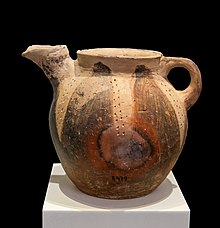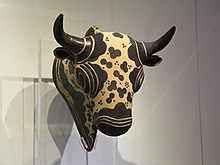User:Gd.camacho94/sandbox
Many different styles of potted wares and techniques of production are observable throughout the history of Crete. Early Minoan ceramics were characterized by patterns of spirals, triangles, curved lines, crosses, fish bones, and beak-spouts. However, while many of the artistic motifs are similar in the Early Minoan period, there are many differences that appear in the reproduction of these techniques through out the island. During the Middle Minoan period, naturalistic designs (such as fish, squid, birds and lilies) were common. In the Late Minoan period, flowers and animals were still characteristic but more variety existed.
EM I Wares[edit]
One of the earliest styles in EM I was the Coarse Dark Burnished class. The dark burnished class most closely mimics the techniques of the Neolithic era. After new techniques allowed for the development of new styles of pottery in the early bronze age, Coarse Dark Burnished class remained in production, and while most wares from the Coarse Dark Burnished class are generally less extravagant than other styles that utilize the technological developments that emerged during EM I, some examples of intricate pieces exist[1]. This may suggest that there was a desire within the communities who produced Coarse Dark Burnished ware to separate themselves from the communities who produced wares with the new techniques.

The Aghious Onouphrios and the Lebena classes were two of the most widespread styles of pottery that used techniques of which there are no antecedent examples[2] . Both techniques utilized a variety of new techniques, for example the selection and handling of materials, the firing process, sapping and ornamentation. Both styles used fine patterns of lines to ornament the vessels. In the case of Aghious Onouphrios, vessel had a white backing and were painted with red lining. Conversely, in the case of the Lebena style white lines were painted above a red background.
Another EM I class was Pirgos ware. The style may have been imported,[3] and perhaps mimics wood. Prigos wares utilize a combination of old and new techniques. Prigos wares a subdivision of the Fine Dark Burnished class that have burnished patterns. The patterning is likely due to the an inability to effectively paint the styles dark background[4].
These three classes of EM I pottery adequately reveal the diversity of techniques that emerged during the period. The Coarse Dark Burnished class continued to use techniques that were already in use, the Aghious Onouphrios and Lebana class used completely new techniques, and the Fine Dark Burnished class used a combination of old and new techniques. However a variety of other EM I wares have been discovered, e.g. the Scored, Red to Brown Monochrome, and the Cycladic classes. Additionally, all of the classes utilized different shapes of pottery.
EM II-III Wares[edit]

In the first phase of Early Minoan, the Aghious Onouphrios ware is most common. Vasiliki ware is found in East Crete during the EM IIA period, but it is in the next period, EM IIB, that it becomes the dominant form among the fine wares throughout eastern and southern Crete.[5] Both styles contain a reddish wash.[6] However, Vasiliki ware has a unique mottled finish that distinguishes it from the EM I styles pottery. At times this mottled finish is deliberate and controlled and at others it seems uncontrolled. Like EM I, a variety classifications of Pottery emerged during this period. Koumasa ware is a development of Aghious and Lebana styles of pottery and was prominent in EM IIA, prior to Vasiliki wares increased popularity. Additionally, gray wares continued to be produced throughout EMII and a Fine Gray class of wares emerges. The Fine Gray class follows the trend of the majority of EM II pottery and is a remarkably higher quality than previous wares[7].
EM III, the final phase of the early Minoan period, is dominated by the White-On-Dark class. Some locations have been discovered that housed over 90% White-On-Dark ware. The class utilizes complex spirals and other ornate patterning that have naturalistic appearances. But, not all producers of these wares used these patterns at the same time. Rather, the motifs caught hold over an extended period of time. These developments set the mood for the new classes that would emerge in the Middle Minoan period.
EM II-III are marked by a refining of the techniques and styles of pottery that emerged and evolved during EM I and these refinements would ultimately set the themes for the later works of Minoan and Mycenaean pottery.
MM Wares[edit]

Pottery became more common with the building of the palaces and the potter's wheel.[8] Kamares ware is most typical of this period. The MM period was dominated by the development of monumental palaces. These places centralized the production of potted wares. This centralization led artists to become more aware of what other craftsmen were producing and wares became more homogeneous in shapes in styles[9].
While the pottery became more homogeneous in style during MM, the wares did not become any less ornate. Indeed, during the MM period the most elaborate decorations of any previous period emerge. The Kamares ware that came to dominated the period utilized flower, fish, and other naturalistic ornamentation, and although the White-On-Gray class had begun to articulate prototypes of these patterns in EM III, the new decorative techniques of this period have no parallel.
LM Wares[edit]

The palace style of the region around Knossos is characterized by geometric simplicity and monochromatic painting. LM wares continued the extravagance of decoration that became popular during the MM period. The patterns and images that were used to decorate pottery became more detailed and more varied. The Floral Style, Marine style, Abstract Geometric and the Alternating styles of decoration were prominent themes of this era. Additionally, potted wares that depicted animals, e.g. the head's of bulls, became popular during LM. These decorative pieces were painted with the popular patterns of the time creating some of the most elaborate of all Minoan potted goods[10].
LM pottery achieved the full articulation of the themes and techniques that had existed since the neolithic era. Yet, this articulation was not the product of linear development. Rather, it was produced through the dynamic exchange of ideas and techniques and will to break away from, as well as to conform to, previous molds of production. Late Minoan art in turn influenced that of Mycenae. Minoan knowledge of the sea was continued by the Mycenaeans in their frequent use of marine forms as artistic motifs. The so marine style, perhaps inspired by frescoes, has the entire surface of a pot covered with sea creatures, octopus, fish and dolphins, against a background of rocks, seaweed and sponges.
- ^ Betancourt, Philip (2009). The Bronze Age Begins. INSTAP. pp. 44–47.
- ^ Betancourt, Philip (2009). The Bronze Age Begins. INSTAP. p. 43.
- ^ https://books.google.com/books?id=esSIAgAAQBAJ&pg=PT96
- ^ Betancourt, Philip (2009). The Bronze Age Begins. INSTAP. p. 56.
- ^ Minoan settlement of Vasiliki minoancrete.com
- ^ Pedley, pp. 36–37
- ^ Betancourt, Philip (1985). The History of Minoan Pottery. Princeton University Press. pp. 35–38.
- ^ Pedley, p. 52
- ^ Betancourt, Philip (1985). The History of Minoan Pottery. Princeton University Press. p. 64.
- ^ Betancourt, Philip (1985). The History of Minoan Pottery. Princeton University Press. pp. 144–149.
